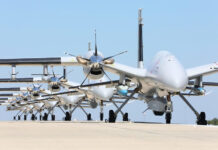The Canadian Air Force is modernizing 80 CF-18 Hornets fighter aircraft. The program, conducted by Boeing International is pursued in two phases. In August 2006 Boeing completed phase I with the delivery of the 80th aircraft.
Phase I is considered the cornerstone CF-18 modernization project, providing the fleet with secure communications interoperability. The aircraft were equipped with an improved radar, compatible with air/air AMRAAM missiles, HAVE-QUICK jam-resistant radios, a combined interrogator-transponder (IFF), stores management systems, mission computers, and embedded global positioning and inertial navigation systems (GPS/INS). Phase I modernizations are enabling Canadian Hornets to become fully interoperable with coalition forces.
Phase II began prototype modification in January 2006. This package will outfit baseline CF-18s Phase I aircraft with Link 16 datalinks, provided by the US based Datalink Systems Company. The system will enable the aircraft to share information with other jets, ground stations and airborne warning and control systems (AWACS). Information will be displayed on new colour display panels, providing pilots with improved access to flight data and communications.
The pilots will gain improved situational awareness by large color multifunction displays and helmet mounted cueing and sight system (JHMCS). First flights in Canadian F/A-18s are scheduled for September 2006. A new ejection seat will be installed, in support of the new helmet display system. The aircraft will also be outfitted with a new missile countermeasures chaff/flare dispenser. Two prototypes are currently being modified at the Naval Air Warfare Center, in China Lake, California. Production is planned to begin in October 2006 at the L3 Communications MAS facilities in Mirabel, Quebec.
To date the program consumed about C$2.3-billion. It is scheduled to span over eight years.

















